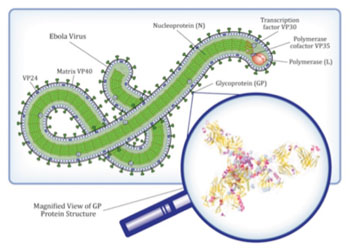Online Tool Designed to Aid Ebola Researchers
By LabMedica International staff writers
Posted on 25 Dec 2014
Biotech researchers and drug developers seeking to find ways to control the Ebolavirus outbreak now have free access to a new online tool that enables visualization of Ebola gene mutations in the context of three-dimensional protein structures.Posted on 25 Dec 2014
The Internet site called MuPIT (Mutation Position Imaging Toolkit) Ebola Edition was prepared by biomedical engineers at Johns Hopkins University (Baltimore, MD, USA). This first version of the program, which can be accessed online (please see related links below) provides visualization of user-specified mutations as well as mutations from 101 viral genome sequences, derived from blood samples taken from Ebola patients in West Africa. It includes functional annotations from the [US] National Institutes of Health's Universal Protein Resource database and epitope sequences from the [US] National Institute of Allergy and Infectious Diseases' Immune Epitope and Analysis Resource.

Image: Illustration depicts the Ebolavirus and proteins on its surface that may provide targets for new drugs that could help treat or prevent Ebola infections (Photo courtesy of the Johns Hopkins University).
The MuPIT Ebola Edition browser was designed to interact with the new Ebola Genome Browser released recently by the University of California, Santa Cruz (USA). The Ebola Genome Browser offers detailed genetic information about the virus while MuPIT provides three-dimensional views of Ebola’s proteins, making it easier to interpret the functional implications of mutations and their relationship to Ebolavirus evolution and its potential vulnerabilities.
“Learning more about the mutations and binding sites can be enormously valuable in developing new and better ways to treat Ebola patients and, ideally, to keep the virus from infecting people in the first place,” said Dr. Rachel Karchin, associate professor of biomedical engineering at Johns Hopkins University. “Understanding the evolutionary and functional importance of mutations in the Ebola genome is important because it can help us anticipate how the virus will change in the future and then help us to design vaccines capable of neutralizing the virus and protecting against infection.”
Related Links:
Johns Hopkins University
MuPIT Ebola Edition
University of California, Santa Cruz








 (3) (1).png)





